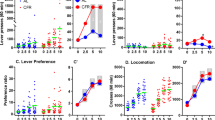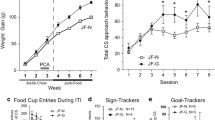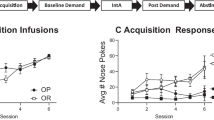Abstract
Rationale
Approach behavior is regulated by the brain integrating information about environment and body state. Psychoactive drugs interact with this process.
Objectives
We examined the extent to which caloric (i.e., food) restriction, amphetamine (AMPH) and lithium interact in potentiating locomotor activity and responding reinforced by visual stimulus (VS), a reward unrelated to energy homeostasis.
Methods
Rats either had ad libitum access to food or received daily rations that maintained 85–90 % of their original body weights. Leverpressing turned on a cue light for 1 s and turned off house light for 5 s. AMPH and lithium were administered through intraperitoneal injections and diet, respectively.
Results
Food restriction or AMPH (1 mg/kg) alone had little effect on VS-reinforced responding; however, the combination of the two conditions markedly potentiated VS-reinforced responding (fourfold). Food restriction lasting 7 days or longer was needed to augment AMPH's effect on VS-reinforced responding. AMPH (0.3–3 mg/kg) potentiated locomotor activity similarly between food-restricted and ad libitum groups. Repeated injections of AMPH-sensitized locomotor activity, but not VS-reinforced responding. In addition, while chronic lithium treatments (0.2 % lithium carbonate chow) reduced VS-reinforced responding, chronic lithium further augmented AMPH-potentiated VS-reinforced responding.
Conclusions
Food restriction interacts with psychoactive drugs to potentiate goal-directed responding unrelated to food seeking in a much more powerful manner than previously thought. The novel finding that lithium can augment a psychostimulant effect of AMPH suggests caution when combining lithium and psychostimulant drugs in clinical settings.





Similar content being viewed by others
References
American Psychiatric Association (2000) Diagnostic and statistical manual of mental disorders: DSM-IV-TR. American Psychiatric Association, Washington, DC, p 567
Bardo MT, Bowling SL, Robinet PM, Rowlett JK, Lacy M, Mattingly BA (1993) Role of dopamine D1 and D2 receptors in novelty-maintained place preference. Exp Clin Psychopharmacol 1:101–109
Beninger RJ, Ranaldi R (1992) The effects of amphetamine, apomorphine, SKF 38393, quinpirole and bromocriptine on responding for conditioned reward in rats. Behav Pharmacol 3:155–163
Berlyne DE, Koenig ID, Hirota T (1966) Novelty, arousal, and the reinforcement of diversive exploration in the rat. J Comp Physiol Psychol 62:222–226
Bevins RA, Besheer J, Palmatier MI, Jensen HC, Pickett KS, Eurek S (2002) Novel-object place conditioning: behavioral and dopaminergic processes in expression of novelty reward. Behav Brain Res 129:41–50
Bindra D (1968) Neuropsychological interpretation of the effects of drive and incentive-motivation on general activity and instrumental behavior. Psychol Rev 75:1–22
Bindra D (1969) The interrelated mechanisms of reinforcement and motivation, and the nature of their influence on response. In: Arnold WJ, Levine D (eds) Nebraska symposium on motivation, vol. 17. University of Nebraska Press, Lincoln, pp 1–33
Bond DJ, Hadjipavlou G, Lam RW, McIntyre RS, Beaulieu S, Schaffer A, Weiss M (2012) The Canadian network for mood and anxiety treatments (CANMAT) task force recommendations for the management of patients with mood disorders and comorbid attention-deficit/hyperactivity disorder. Ann Clin Psychiatry 24:23–37
Bowden CL, Brugger AM, Swann AC, Calabrese JR, Janicak PG et al (1994) Efficacy of divalproex vs lithium and placebo in the treatment of mania. JAMA 271:918–924
Brauer LH, de Wit H (1996) Subjective responses to d-amphetamine alone and after pimozide pretreatment in normal, healthy volunteers. Biol Psychiatry 39:26–32
Breitbart W, Alici Y (2010) Psychostimulants for cancer-related fatigue. J Natl Compr Cancer Netw 8:933–942
Cabeza de Vaca S, Carr KD (1998) Food restriction enhances the central rewarding effect of abused drugs. J Neurosci 18:7502–7510
Cabeza de Vaca S, Krahne LL, Carr KD (2004) A progressive ratio schedule of self-stimulation testing in rats reveals profound augmentation of d-amphetamine reward by food restriction but no effect of a “sensitizing” regimen of d-amphetamine. Psychopharmacology 175:106–113
Carr KD (2002) Augmentation of drug reward by chronic food restriction: behavioral evidence and underlying mechanisms. Physiol Behav 76:353–364
Carr KD, Wolinsky TD (1993) Chronic food restriction and weight loss produce opioid facilitation of perifornical hypothalamic self-stimulation. Brain Res 607:141–148
Cassidy F, Ahearn EP, Carroll BJ (2001) Substance abuse in bipolar disorder. Bipolar Disord 3:181–188
Chaudhri N, Caggiula AR, Donny EC, Palmatier MI, Liu X, Sved AF (2006) Complex interactions between nicotine and nonpharmacological stimuli reveal multiple roles for nicotine in reinforcement. Psychopharmacology (Berlin) 184:353–366
Clark FC (1966) Effects of d-amphetamine on performance under a multiple schedule in the rat. Psychopharmacology 9:157
Cohen SL (1991) Food-paired stimuli as conditioned reinforcers: effects of d-amphetamine. J Exp Anal Behav 56:277
Damasio AR (2010) Self comes to mind. Vintage Books, New York
D'Cunha T, Sedki F, Macri J, Casola C, Shalev U (2013) The effects of chronic food restriction on cue-induced heroin seeking in abstinent male rats. Psychopharmacology 225:241–250
Deroche V, Piazza PV, Casolini P, Le Moal M, Simon H (1993) Sensitization to the psychomotor effects of amphetamine and morphine induced by food restriction depends on corticosterone secretion. Brain Res 611:352–356
Dickinson A, Balleine B (1994) Motivational control of goal-directed action. Anim Learn Behav 22:1–18
Dickinson A, Smith J, Mirenowicz J (2000) Dissociation of Pavlovian and instrumental incentive learning under dopamine antagonists. Behav Neurosci 114:468–483
Donny EC, Chaudhri N, Caggiula AR, Evans-Martin FF, Booth S, Gharib MA, Clements LA, Sved AF (2003) Operant responding for a visual reinforcer in rats is enhanced by noncontingent nicotine: implications for nicotine self-administration and reinforcement. Psychopharmacology (Berlin) 169:68–76
Duchesne V, Boye SM (2013) Differential contribution of mesoaccumbens and mesohabenular dopamine to intracranial self-stimulation. Neuropharmacology 70:43–50
Ebstein RP, Eliashar S, Belmaker RH, Ben-Uriah Y, Yehuda S (1980) Chronic lithium treatment and dopamine-mediated behavior. Biol Psychiatry 15:459–467
Fessler RG, Sturgeon RD, London SF, Meltzer HY (1982) Effects of lithium on behaviour induced by phencyclidine and amphetamine in rats. Psychopharmacology 78:373–376
Flagel SB, Clark JJ, Robinson TE, Mayo L, Czuj A, Willuhn I, Akers CA, Clinton SM, Phillips PEM, Akil H (2011) A selective role for dopamine in stimulus-reward learning. Nature 469:53–57
Forgays DG, Levin H (1958) Learning as a function of change of sensory stimulation in food-deprived and food-satiated animals. J Comp Physiol Psychol 51:50–54
Fox SS (1962) Self-maintained sensory input and sensory deprivation in monkeys: a behavioral and neuropharmacological study. J Comp Physiol Psychol 55:438–444
Gerdjikov T, Baker T, Beninger R (2011) Amphetamine-induced enhancement of responding for conditioned reward in rats: interactions with repeated testing. Psychopharmacology 214:891–899
Goodrick CL (1965) Operant level and light-contingent bar presses as a function of age and deprivation. Psychol Rep 17:283–288
Gould TD, O'Donnell KC, Picchini AM, Manji HK (2007) Strain differences in lithium attenuation of d-amphetamine-induced hyperlocomotion: a mouse model for the genetics of clinical response to lithium. Neuropsychopharmacology 32:1321–1333
Guy EG, Fletcher P (2013) Nicotine-induced enhancement of responding for conditioned reinforcement in rats: role of prior nicotine exposure and α4β2 nicotinic receptors. Psychopharmacology 225:429–440
Hasler G, Drevets WC, Gould TD, Gottesman II, Manji HK (2006) Toward constructing an endophenotype strategy for bipolar disorders. Biol Psychiatry 60:93–105
Herling S, Downs D, Woods J (1979) Cocaine, d-amphetamine, and pentobarbital effects on responding maintained by food or cocaine in rhesus monkeys. Psychopharmacology 64:261–269
Hill RT (1970) Facilitation of conditioned reinforcement as a mechanism of psychomotor stimulation. In: Costa E, Garatitini S (eds) Amphetamine and related compounds. Raven Press, New York, pp 781–795
Hoebel BG, Teitelbaum P (1962) Hypothalamic control of feeding and self-stimulation. Science 135:375–376
Hoffman DC, Beninger RJ (1985) The D1 dopamine receptor antagonist, SCH 23390 reduces locomotor activity and rearing in rats. Pharmacol Biochem Behav 22:341–342
Ikemoto S (2010) Brain reward circuitry beyond the mesolimbic dopamine system: a neurobiological theory. Neurosci Biobehav Rev 35:129–150
Ikemoto S, Panksepp J (1999) The role of nucleus accumbens dopamine in motivated behavior: a unifying interpretation with special reference to reward-seeking. Brain Res Rev 31:6–41
Ikemoto S, Qin M, Liu ZH (2005) The functional divide for primary reinforcement of d-amphetamine lies between the medial and lateral ventral striatum: is the division of the accumbens core, shell and olfactory tubercle valid? J Neurosci 25:5061–5065
Ikemoto S, Qin M, Liu ZH (2006) Primary reinforcing effects of nicotine are triggered from multiple regions both inside and outside the ventral tegmental area. J Neurosci 26:723–730
Jefferson JW (1990) Lithium: the present and the future. J Clin Psychiatry 51:4–8
Kelley AE, Delfs JM (1991) Dopamine and conditioned reinforcement: I. Differential effects of amphetamine microinjections into striatal subregions. Psychopharmacology 103:187–196
Kiernan CC (1965) Modification of the effects of amphetamine sulphate by past experience in the hooded rat. Psychopharmacology 8:23–31
Kish GB (1966) Studies of sensory reinforcement. In: Honing WK (ed) Operant behavior: Areas of research and application. Appleton-Century-Crofts, New York, pp 109–159
Lerer B, Globus M, Brik E, Hamburger R, Belmaker RH (1984) Effect of treatment and withdrawal from chronic lithium in rats on stimulant-induced responses. Neuropsychobiology 11:28–32
Margules DL, Olds J (1962) Identical “feeding” and “rewarding” systems in the lateral hypothalamus of rats. Science 135:374–375
Marinković P, Pešić V, Lončarević N, Smiljanić K, Kanazir S, Ruždijić S (2007) Behavioral and biochemical effects of various food-restriction regimens in the rats. Physiol Behav 92:492–499
Masoro EJ (2000) Caloric restriction and aging: an update. Exp Gerontol 35:299–305
McDonald JH (2009) Handbook of biological statistics. Sparky House, Baltimore
McElroy SL, Altshuler LL, Suppes T, Paul E, Keck J, Frye MA, Denicoff KD, Nolen WA, Kupka RW, Leverich GS, Rochussen JR, Rush AJ, Post RM (2001) Axis I psychiatric comorbidity and its relationship to historical illness variables in 288 patients with bipolar disorder. Am J Psychiatry 158:420–426
Michalsen A (2010) Prolonged fasting as a method of mood enhancement in chronic pain syndromes: a review of clinical evidence and mechanisms. Curr Pain Headache Rep 14:80–87
National Research Council (2011) Guide for the care and use of laboratory animals. National Academies Press, Washington, DC
National Task Force on the Prevention and Treatment of Obesity (1996) Long-term pharmacotherapy in the management of obesity: national task force on the prevention and treatment of obesity. JAMA 276:1907–1915
NDP Group (2013) The NPD Group reports dieting is at an all-time low-dieting season has begun, but it's not what it used to be! Available via https://www.npd.com/wps/portal/npd/us/news/press-releases/the-npd-group-reports-dieting-is-at-an-all-time-low-dieting-season-has-begun-but-its-not-what-it-used-to-be/. Accessed 30 Aug 2013
Niv Y, Daw ND, Joel D, Dayan P (2007) Tonic dopamine: opportunity costs and the control of response vigor. Psychopharmacology (Berlin) 191:507–520
O’Donnell KC, Gould TD (2007) The behavioral actions of lithium in rodent models: leads to develop novel therapeutics. Neurosci Biobehav Rev 31:932–962
Olausson P, Jentsch JD, Taylor JR (2004) Nicotine enhances responding with conditioned reinforcement. Psychopharmacology 171:173–178
Olds ME (1970) Comparative effects of amphetamine, scopolamine, chlordiazepoxide, and diphenylhydantoin on operant and extinction behavior with brain stimulation and food reward. Neuropharmacology 9:519–532
Panksepp J (1998) Affective neuroscience: The foundations of human and animal emotions. Oxford University, New York
Parkinson JA, Roberts AC, Everitt BJ, Di Ciano P (2005) Acquisition of instrumental conditioned reinforcement is resistant to the devaluation of the unconditioned stimulus. Q J Exp Psychol B 58:19–30
Pliszka S (2007) Practice parameter for the assessment and treatment of children and adolescents with attention-deficit/hyperactivity disorder. J Am Acad Child Adolesc Psychiatry 46:894–921
Regier DA, Farmer ME, Rae DS, Locke BZ, Keith SJ, Judd LL, Goodwin FK (1990) Comorbidity of mental disorders with alcohol and other drug abuse: results from the epidemiologic catchment area (eca) study. JAMA 264:2511–2518
Rescorla RA, Solomon RL (1967) Two-process learning theory: relationships between Pavlovian conditioning and instrumental learning. Psychol Rev 74:151–182
Robbins TW (1975) The potentiation of conditioned reinforcement by psychomotor stimulant drugs. A test of Hill's hypothesis. Psychopharmacologia 45:103–114
Robbins TW (1978) The acquisition of responding with conditioned reinforcement: effects of pipradrol, methylphenidate, d-amphetamine, and nomifensine. Psychopharmacology (Berlin) 58:79–87
Robbins TW, Koob GF (1978) Pipradrol enhances reinforcing properties of stimuli paired with brain stimulation. Pharmacol Biochem Behav 8:219–222
Robinson TE, Becker JB (1986) Enduring changes in brain and behavior produced by chronic amphetamine administration: a review and evaluation of animal models of amphetamine psychosis. Brain Res Rev 11:157–198
Ross RG (2006) Psychotic and manic-like symptoms during stimulant treatment of attention deficit hyperactivity disorder. Am J Psychiatry 163:1149–1152
Segal EF (1959) Confirmation of a positive relation between deprivation and number of responses emitted for light reinforcement. J Exp Anal Behav 2:165–169
Shin R, Cao J, Webb SM, Ikemoto S (2010) Amphetamine administration into the ventral striatum facilitates behavioral interaction with unconditioned visual signals in rats. PLoS ONE 5:e8741
Staunton DA, Magistretti PJ, Shoemaker WJ, Bloom FE (1982) Effects of chronic lithium treatment on dopamine receptors in the rat corpus striatum: I. Locomotor activity and behavioral supersensitivity. Brain Res 232:391–400
Stewart J, Hurwitz HMB (1958) Studies in light-reiforced behaviour: III. The effect of continuous, zero and fixed-ratio reinforcement. Q J Exp Psychol 10:56–61
Taylor JR, Robbins TW (1984) Enhanced behavioral control by conditioned reinforcers following microinjections of d-amphetamine into the nucleus accumbens. Psychopharmacology 84:405–412
Thomsen K, Olesen OV (1974) Long-term lithium administration to rats. Lithium and sodium dosage and administration, avoidance of intoxication, polyuric control rats. Int Pharmacopsychiatry 9:118–124
Trepanowski JF, Bloomer RJ (2010) The impact of religions fasting on human health. Nutr J 9:57
Van Kammen DP, Murphy DL (1975) Attenuation of the euphoriant and activating effects of d- and L-amphetamine by lithium carbonate treatment. Psychopharmacology 44:215–224
van Kammen DP, Docherty JP, Marder SR, Rosenblatt JE, Bunney WE (1985) Lithium attenuates the activation—euphoria but not the psychosis induced by d-amphetamine in schizophrenia. Psychopharmacology 87:111–115
Vollrath-Smith FR, Shin R, Ikemoto S (2012) Synergistic interaction between baclofen administration into the median raphe nucleus and inconsequential visual stimuli on investigatory behavior of rats. Psychopharmacology 220:15–25
Wassum KM, Ostlund SB, Loewinger GC, Maidment NT (2013) Phasic mesolimbic dopamine release tracks reward seeking during expression of pavlovian-to-instrumental transfer. Biol Psychiatry 73:747–755
Webb SM, Vollrath-Smith F, Shin R, Jhou T, Xu S, Ikemoto S (2012) Rewarding and incentive motivational effects of excitatory amino acid receptor antagonists into the median raphe and adjacent regions of the rat. Psychopharmacology 224:401–412
Wise RA, Munn E (1993) Effects of repeated amphetamine injections on lateral hypothalamic brain stimulation reward and subsequent locomotion. Behav Brain Res 55:195–201
Wyvell CL, Berridge KC (2000) Intra-accumbens amphetamine increases the conditioned incentive salience of sucrose reward: enhancement of reward “wanting” without enhanced “liking” or response reinforcement. J Neurosci 20:8122–8130
Young JW, Henry BL, Geyer MA (2011) Predictive animal models of mania: hits, misses and future directions. Br J Pharmacol 164:1263–1284
Zhang J, Berridge KC, Tindell AJ, Smith KS, Aldridge JW (2009) A neural computational model of incentive salience. PLoS Comput Biol 5:e1000437
Acknowledgments
The present work was supported by the Intramural Research Program of National Institute on Drug Abuse, National Institutes of Health. The authors thank Ms. Amy N. Hamaker for conducting a pilot experiment and Dr. T. D. Gould for helping with lithium concentration analysis.
Financial Disclosures
The authors have no financial disclosure to make.
Author information
Authors and Affiliations
Corresponding author
Rights and permissions
About this article
Cite this article
Keller, K.L., Vollrath-Smith, F.R., Jafari, M. et al. Synergistic interaction between caloric restriction and amphetamine in food-unrelated approach behavior of rats. Psychopharmacology 231, 825–840 (2014). https://doi.org/10.1007/s00213-013-3300-9
Received:
Accepted:
Published:
Issue Date:
DOI: https://doi.org/10.1007/s00213-013-3300-9




